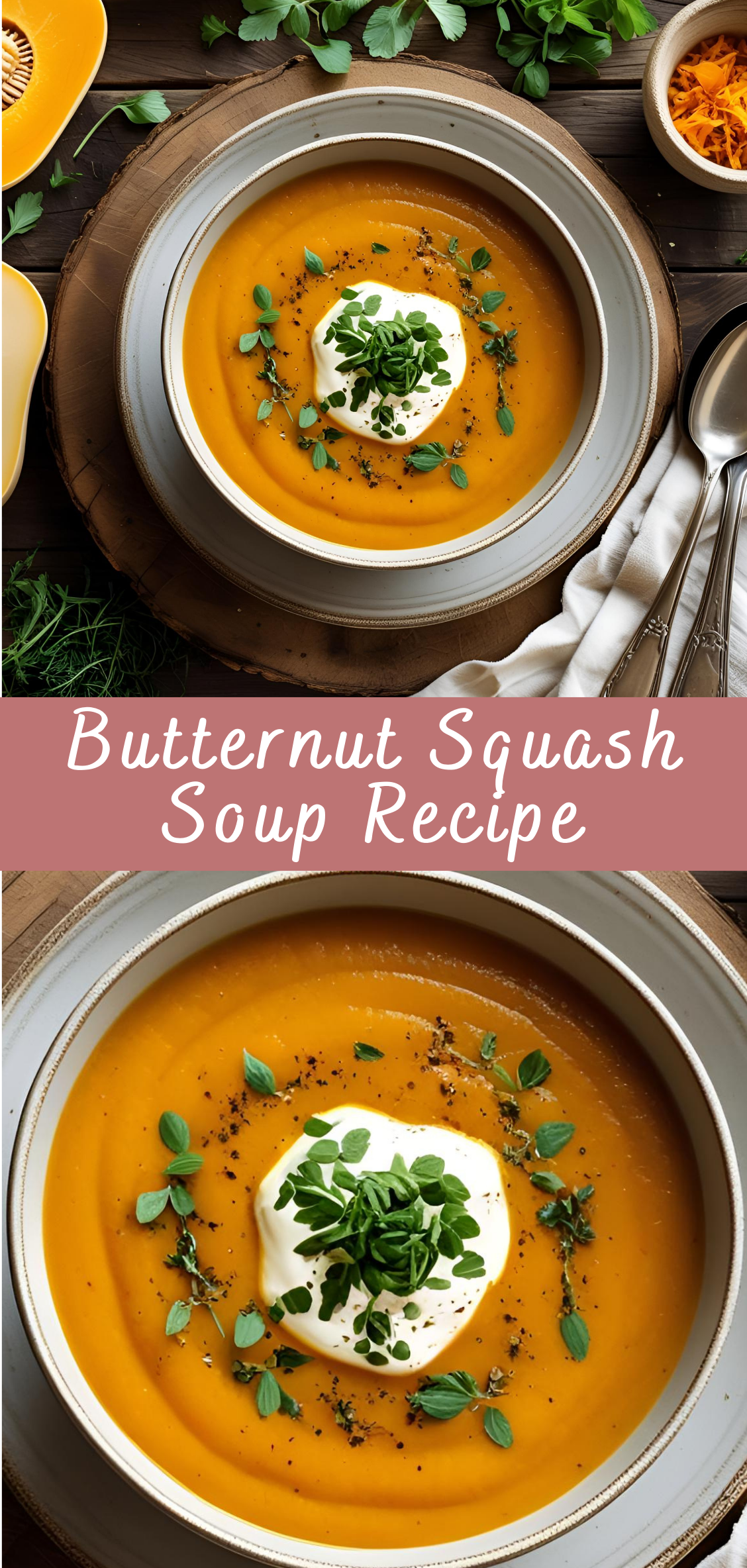Butternut Squash Soup Recipe
Butternut squash soup is more than just a seasonal comfort food—it is a dish steeped in history, rich in nutrition, and beloved in kitchens around the world for its smooth texture, subtly sweet flavor, and adaptability. Whether served as a cozy starter during the fall and winter months or reimagined as a vibrant summer dish with fresh herbs and chilled presentations, this soup has proven itself to be a culinary staple across cultures and cuisines.

Originating from humble beginnings, butternut squash, the star ingredient in this soup, is a variety of winter squash that has been cultivated for centuries in the Americas. Native to the Western Hemisphere, squash was a central component of Indigenous American diets long before European settlers arrived. Over time, butternut squash evolved through selective cultivation to become the variety we recognize today, prized for its nutty flavor, smooth flesh, and ease of preparation.
The soup itself draws on a long tradition of vegetable-based purees, which have historically served as both sustenance and solace. In European kitchens, particularly in France, velouté and potage soups have long held a place of prominence. These elegant, smooth-textured soups became foundational recipes for aspiring chefs and home cooks alike, offering a template that could be adapted with a variety of local produce. Butternut squash soup naturally aligns with this culinary lineage, marrying Old World techniques with New World ingredients.
In recent years, the popularity of butternut squash soup has surged—not only because of its comforting flavor profile but also due to a growing awareness of plant-based nutrition. As more individuals seek alternatives to heavily processed meals or meat-centric diets, butternut squash soup offers a delicious and nutrient-rich option. Packed with vitamins A and C, fiber, potassium, and antioxidants, it provides a wealth of health benefits without sacrificing flavor or culinary sophistication.
Beyond its nutritional appeal, butternut squash soup is also celebrated for its incredible versatility. It can be seasoned with warming spices like cinnamon and nutmeg for a traditional autumnal version, or infused with ingredients such as coconut milk, ginger, and lemongrass to evoke Thai or Caribbean flavors. It can be served hot or cold, garnished with roasted seeds, fresh herbs, or a swirl of cream, and paired seamlessly with rustic breads, leafy salads, or grilled meats. Its adaptability has made it a favorite of professional chefs and home cooks alike.
This comprehensive guide to butternut squash soup will explore every facet of this beloved dish—from its origins and health benefits to its preparation techniques and recipe variations. Whether you’re an experienced cook or a kitchen novice, this guide will offer insights, tips, and step-by-step instructions designed to help you create the perfect bowl of soup. We’ll examine ingredient choices, cooking methods, equipment, storage advice, and creative garnishes. Along the way, we’ll also delve into the cultural significance and culinary innovation that have shaped this dish into what it is today.
By the end of this guide, you won’t just know how to make butternut squash soup—you’ll understand why it has endured as a timeless, nourishing, and deeply satisfying meal. Whether you’re cooking for a family dinner, preparing a holiday feast, or simply looking for a healthy and comforting lunch, this soup offers a foundation upon which you can build countless memorable meals.
Part 1: Ingredients and Equipment – What You’ll Need
Before beginning the cooking process, it’s essential to gather all necessary ingredients and kitchen tools. Preparation ensures a smooth cooking experience and minimizes the risk of missing a crucial step mid-process.
Ingredients (Serves 4 to 6):
Main Ingredients:
-
1 large butternut squash (about 2.5 to 3 pounds), peeled, seeded, and cubed
-
1 medium yellow onion, chopped
-
2 cloves garlic, minced
-
1 large carrot, peeled and chopped
-
1 celery stalk, chopped
-
1 medium potato (optional, for extra creaminess), peeled and diced
-
4 cups vegetable broth (or chicken broth for a non-vegetarian version)
-
2 tablespoons olive oil (or unsalted butter for added richness)
-
Salt, to taste
-
Freshly ground black pepper, to taste
Optional Enhancements:
-
½ teaspoon ground nutmeg or cinnamon (for warmth)
-
1 teaspoon fresh thyme leaves (or ½ teaspoon dried)
-
¼ teaspoon ground ginger (for subtle spice)
-
½ cup coconut milk or heavy cream (for creaminess)
-
Roasted pumpkin seeds or chopped herbs for garnish
Equipment:
-
Sharp chef’s knife
-
Large cutting board
-
Vegetable peeler
-
Large soup pot or Dutch oven
-
Wooden spoon or heatproof spatula
-
Blender (immersion or countertop)
-
Ladle
-
Measuring cups and spoons
-
Fine-mesh strainer (optional, for extra smooth texture)
Part 2: Preparation – Step-by-Step Cooking Instructions
Step 1: Preparing the Butternut Squash
Start by peeling the butternut squash using a sharp vegetable peeler. Cut off both ends to create a flat base. Then, slice the squash in half lengthwise. Using a spoon, scoop out the seeds and fibrous strands from the cavity.
Once cleaned, lay the squash halves flat on your cutting board and cut them into evenly sized cubes—roughly 1-inch pieces. Uniform cubes ensure even cooking.
Tip: Save the seeds to roast later for garnish or snacking.
Step 2: Chopping the Aromatics
Dice the onion, mince the garlic, and chop the carrot, celery, and potato. These vegetables will build the flavor foundation for your soup. The finer you chop, the quicker they will soften and integrate into the final texture.
Step 3: Sautéing the Base Vegetables
Place your large soup pot or Dutch oven over medium heat. Add 2 tablespoons of olive oil or butter. Once heated, add the chopped onion, carrot, and celery. Cook, stirring frequently, for 5 to 7 minutes until the vegetables are softened and the onions are translucent.
Next, add the minced garlic and cook for an additional 30 seconds to 1 minute until fragrant—being careful not to burn it.
Optional: Add your spices at this stage (nutmeg, cinnamon, ginger, or thyme) to bloom them in the oil for deeper flavor.
Step 4: Adding the Butternut Squash and Liquids
Add the cubed butternut squash and diced potato (if using) to the pot. Stir well to coat the vegetables with the aromatic oil and spices.
Pour in the vegetable broth. The liquid should just cover the squash—add a bit of water if needed. Bring the mixture to a boil, then reduce the heat to low and cover with a lid.
Simmer the soup gently for 25 to 30 minutes, or until the squash and other vegetables are completely tender and easily pierced with a fork.
Tip: Avoid over-boiling, which can dilute the flavor. A gentle simmer helps retain sweetness and depth.
Step 5: Blending the Soup
Once the vegetables are tender, it’s time to blend the soup.
If using a countertop blender:
-
Allow the soup to cool slightly.
-
Transfer it in batches to your blender. Fill no more than halfway to avoid pressure buildup.
-
Blend on high until completely smooth and creamy.
-
Return blended soup to the pot.
If using an immersion blender:
-
Keep the soup in the pot.
-
Insert the blender and blend thoroughly until the soup is velvety smooth.
Optional Step: For an ultra-smooth texture, pass the soup through a fine-mesh strainer into a clean pot.
Step 6: Finishing Touches
Return the pot to low heat. Stir in your coconut milk or heavy cream if using. Taste the soup and adjust with salt and pepper as needed.
At this stage, you can also adjust thickness:
-
If too thick, add a bit more broth or water.
-
If too thin, simmer uncovered for a few more minutes to reduce.
Flavor Enhancer Option: A teaspoon of maple syrup or a splash of apple cider vinegar can balance the soup with sweetness or acidity, depending on your taste.
Step 7: Serving and Garnishing
Ladle the soup into bowls. Garnish with any of the following:
-
A swirl of cream or coconut milk
-
Toasted pumpkin seeds or sunflower seeds
-
Chopped fresh parsley, chives, or thyme
-
A drizzle of olive oil or chili oil
-
A sprinkle of smoked paprika or cayenne for heat
Serve hot with crusty bread, a light salad, or as a starter to a larger meal.
Butternut Squash Soup Recipe
Butternut squash soup is more than just a seasonal comfort food—it is a dish steeped in history, rich in nutrition, and beloved in kitchens around the world for its smooth texture, subtly sweet flavor, and adaptability. Whether served as a cozy starter during the fall and winter months or reimagined as a vibrant summer dish with fresh herbs and chilled presentations, this soup has proven itself to be a culinary staple across cultures and cuisines.
Ingredients
- 2 tablespoons olive oil or unsalted butter
- 1 medium yellow onion, chopped
- 2–3 cloves garlic, minced
- 1 large butternut squash (about 2.5 to 3 lbs), peeled, seeded, and cubed
- 1 medium carrot, peeled and chopped
- 4 cups vegetable broth (or chicken broth)
- 1/2 teaspoon salt (or to taste)
- 1/4 teaspoon black pepper
- 1/4 teaspoon ground nutmeg or cinnamon (optional, for warmth)
- 1/2 cup coconut milk or heavy cream (optional, for creaminess)
- Fresh herbs for garnish: thyme, sage, or parsley (optional)
Instructions
- Sauté aromatics:
In a large pot or Dutch oven, heat olive oil or butter over medium heat. Add chopped onion and sauté until translucent (about 5 minutes). Add garlic and cook for another 1 minute. - Add vegetables:
Stir in the cubed butternut squash and carrot. Cook for about 5 more minutes, stirring occasionally. - Add broth & simmer:
Pour in the broth and add salt, pepper, and optional spices. Bring to a boil, then reduce heat and simmer uncovered for 20–25 minutes, or until squash and carrots are very tender. - Blend the soup:
Use an immersion blender to purée the soup directly in the pot until smooth. Alternatively, carefully transfer in batches to a blender. (Let it cool slightly before blending if using a traditional blender.) - Finish:
Stir in the coconut milk or cream if using. Taste and adjust seasoning as needed. - Serve:
Ladle into bowls and garnish with fresh herbs, a drizzle of cream, or toasted seeds if desired.
Notes
- For a sweeter soup, roast the squash first at 400°F (200°C) for 30–40 minutes.
- Add a small apple or a pinch of curry powder for variation.
- Make it vegan by using vegetable broth and coconut milk.



